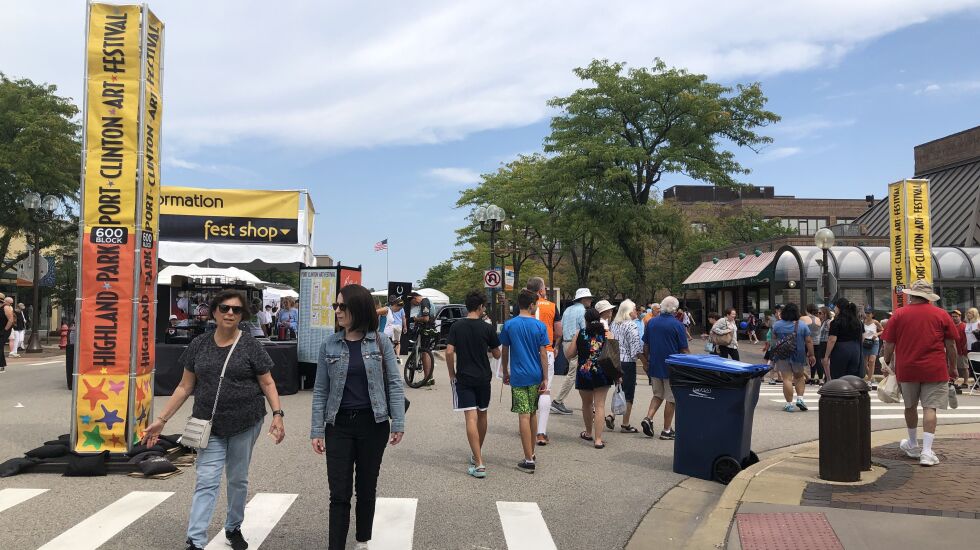

Normal.
According to Merriam Webster, that’s defined as usual, typical or routine.
And for Highland Park, where the July 4 parade massacre on Central Avenue in the city’s downtown left seven dead, at least 48 wounded and scores traumatized, this weekend was a step toward a return to the blessings of normality.
The 39th annual Port Clinton Art Festival drew some 200 exhibitors and thousands of attendees on Saturday and Sunday, with the art show booths spreading east and west on Central Avenue and north and south on adjacent streets. Yes, that’s along the parade route where people were shot or fled the gunfire.
“We have a huge attendance,” said Amy Amdur, the president of Amdur Productions, the Highland Park-based company which produces the festival. “People from Highland Park and the surrounding communities are all here. I think they want to show solidarity with Highland Park and they want to show a return to normal.”
There was never a question about staging the art festival, which continued even through the COVID-19 years of 2020 and 2021, Amdur said.
Amdur said Highland Park Mayor Nancy Rotering told her “she really wanted a return to normal. And that’s what we are trying to do. The healing process is going to be different for everybody.”
On Sunday, I talked with Scott Fishman, a photographer whose booth featured large scale images of iconic Chicago scenes he shot from helicopters or rooftops — not photos made from drones. His booth location was on Central Avenue, in front of Port Clinton Square, near Walker Bros.
Once it was clear the show would go on, Fishman, a Wilmette native who lives in River North, said, “I figured people would come out, in strong support. … I don’t feel people stayed away because of what happened. I think if anything, maybe some of the younger people with little kids have stayed away, maybe because they were traumatized.”
I also talked with Sue Lances, who lives on Staten Island, in New York, whose booth featured her handmade fabric turned into wearable art. Her booth was near the building where the gunman perched on a rooftop to shoot at the crowd below.
Lances told me she did not hesitate about coming but wondered if people would come. “And then I said, ‘you know what? People are resilient to that. They will get beyond that. They will get strong.”
INFORMAL MEMORIAL TO HIGHLAND PARK VICTIMS: A PLACE FOR HEALING
If art can help soothe the soul, an example is the informal public art memorial to the Highland Park massacre victims, which has sprouted up on Central Avenue at St. Johns Avenue just east of the Metra tracks, under an open air shelter — on the parade route.
It is meant to be a place of comfort, artist Jacqueline von Edelberg — the force behind this installation — told me.
Things in it change all the time. There are art activities for kids. I pass by often — there is a constant stream of people coming through.
By coincidence, before the July 4 attack, Edelberg, at the Art Center of Highland Park had thousands of pieces of orange fabric on display to protest gun violence — put in place in the wake of the Uvalde, Texas, school shooting in May. Days later, the same horror hit Highland Park. Orange became the color of the movement to reduce gun violence following the 2013 murder, on Chicago’s South Side, of Hadiya Pendleton.
The shelter had become an ad hoc memorial to the seven dead about a week after the shooting when Edelberg first came upon it. But the place, she said, “seemed a little sadder than it needed to be” and she started wrapping the posts in orange yarn.
There’s an orange desk with pens where people can write cards and tie it to posts. Edelberg said there are now some 6,000 messages. There is an orange mailbox for people to write to Cooper Roberts, the 8-year-old Highland Park boy paralyzed in the July 4 shooting. People wrap rocks with the orange yarn.
What happens to this space in the future — as the city ponders a permanent memorial — is an open question.
Said Edelberg, “People come and they experience the space any way they want to experience the space. So some people are grieving. Some people are curious. Some people are sad. Some people are healing, but ultimately, this place we hope will be a place of peace and comfort and healing and hopefulness.”







